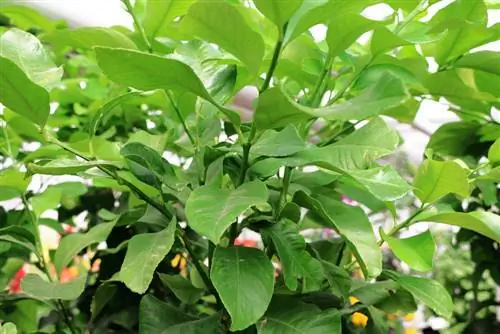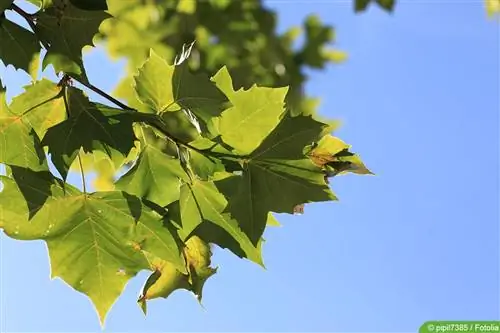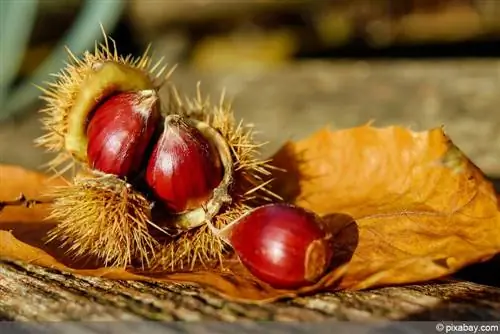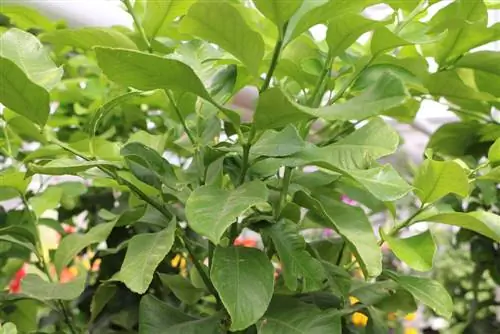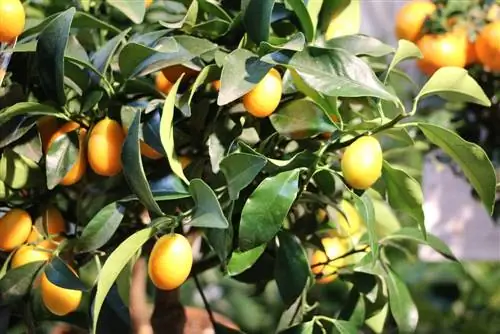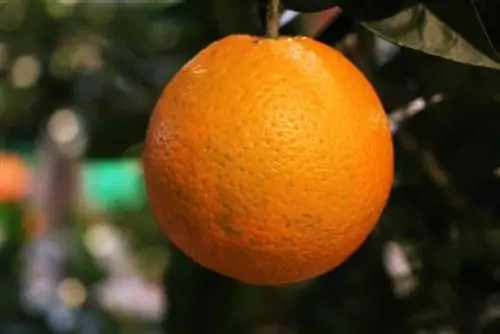- Author admin [email protected].
- Public 2023-12-17 03:39.
- Last modified 2025-01-24 12:45.
The apricot tree, which comes from Southeast Asia, grows as a small or medium-sized tree. Its very elegant-looking, pure white and captivatingly scented flowers appear in spring. Small green oranges develop from them, which take on their typical orange color towards winter. After purchasing a plant, preferably between March and April, the right choice of location and subsequent care are important.
Profile
- Plant family: Rutaceae
- Botanical name: Citrus sinensis
- Origin: Southeast Asia
- Growth: small, bushy shrub or standard tree, partly thorny
- Growth height: up to 100 cm
- Flowers: bright white, large sepals, 2-5-fold
- Flowering period: February to June
- Leaf: evergreen, shiny green, oval
- Fruit: hand-sized, orange citrus fruit
- Lime compatibility: lime tolerant
Care instructions
With the right care, an orange tree can grow and thrive even far away from its old homeland.
Location
The orange tree wants to be very bright and airy all year round. In spring and summer, it feels most comfortable outdoors in a place protected from wind and rain. However, it is also possible to keep it permanently in the winter garden or another bright room. Then the main thing to pay attention to is high humidity and the greatest possible light output.
Substrate
This Mediterranean plant prefers permeable, structurally stable and fresh to moist substrates. They shouldn't be too chalky. Soils that consist of 60% mineral components such as lava rubble, pumice or expanded clay and 40% organic materials such as coconut fiber or bark mulch are ideal. Special soil for citrus plants is also available commercially. Or you can mix commercially available potting soil with compost and perlite or coconut fiber.
Pouring

Water requirements are particularly high in summer. The substrate should always be evenly moist and the above-ground parts of the plant should be sprayed with water more often. Ideally, you should only use stale rainwater or water that is low in lime and not too cold. Allow the substrate to dry slightly between each watering. Dryness of the ball must be avoided at all costs.
Tip:
In order to avoid overwatering the orange tree, so-called moisture meters or hygrometers are recommended.
Fertilize
During the growing season, from April to July, weekly fertilization is mandatory. The orange tree can only tolerate small amounts of phosphorus, but has a high need for nitrogen. That is why it is advisable to use high-quality citrus fertilizers. They are optimally tailored to the special needs of these plants.
Cutting
When cutting an orange tree, you should proceed very carefully and avoid radical cuts, here less is more. Pruning is done to prevent diseases, combat pests or keep the tree in shape. Regular maintenance and shape cuts and, under certain conditions, rejuvenation cuts are recommended.
The right time
In order not to endanger the he alth of the plant, it is important to cut at the right time. A maintenance cut can be made at any time. If there is a disease or a pest infestation, cutting should be carried out immediately. In contrast, training is carried out during winter rest, in late February or early March, depending on the weather.
Conservation cut
- Remove dead and damaged wood during maintenance pruning
- Cutting into the green wood possible
- Cut out diseased and pest-infested parts of the tree
- Even if the damage is unclear
- Leafless, still green shoots, only cut after new growth
- Removing too many he althy branches is so avoidable
- Remove so-called water bullets with
- Water shooters are weak, fast-growing and fruitless shoots
- Cut off as soon as possible after occurrence
Tip:
You can tell whether a branch or twig has died by removing some of the bark. If it is green underneath, the branch is not dead and new growth is possible.
Training or topiary
In contrast to maintenance pruning, this pruning is about actively shaping the plant. It can be combined very well with repotting the tree in late winter. The crown should be shaped into the desired shape, depending on whether it is a large or young tree.
- Small trees first have to increase in size and growth
- Later minor corrections to the outer crown shape
- Under no circumstances cut away all of the new growth
- Only the part that disturbs the external crown shape
- Always cut just above an outward-facing bud
- Inside the crown, remove cross-growing and crossing shoots
- When crossing each other, always cut out the weaker one
- Pruning larger trees much easier
- Outer crown shape should be preserved here
Tip:
For small trees, it can sometimes take several years to achieve the desired crown shape.
Rejuvenation cut
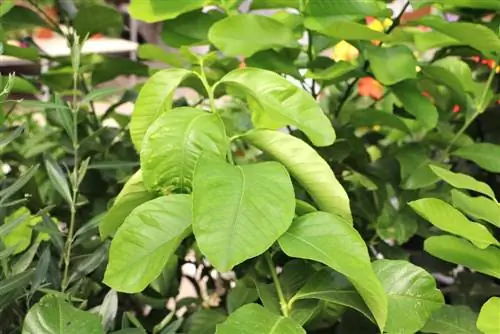
In rare cases, maintenance and shape cuts are not sufficient. This particularly affects specimens that have been neglected for years or are already heavily bare. Then a rejuvenation cut can contribute to the he alth of the plant.
- Best time in early spring
- Test beforehand whether the tree has already died
- Remove some of the bark again
- Cut branches back to just above the first branch
- Stubs short to five to fifteen centimeters
- Normal cut for rejuvenation also possible in late winter
- Short the majority of the branches from the previous year
- About a third or half
Such a radical cut causes buds that are dormant under the bark to sprout under high light intensity and appropriate temperatures and form young wood. However, you have to do without flowers and fruits, at least this season.
Tip:
The tool should be very sharp and clean. Otherwise fungi, viruses and bacteria could be transmitted and damage the plant.
Wintering
Orange trees would not survive German winters outdoors, which is why they are usually kept in pots. However, they should stay outside as long as possible. It's best to place them close to the house until you put them away to protect them from wind and cold. They should only move to winter quarters before the first frost. Beforehand, it is advisable to check the plants for diseases or pest infestation. If there is an infestation, it should be treated or combated immediately. If you do without it, pests in particular can cause great damage in their winter quarters.
The right winter quarters
Orange trees are best overwintered in a light and cool place, at temperatures between eight and ten degrees. Preferably in a greenhouse where temperatures do not fall below five degrees or a cold house. If the winter is cool, it is advisable to additionally protect the root ball by placing the pot on an insulating coconut mat and wrapping the plant itself in jute or fleece.
Alternatively, unheated, bright rooms, such as stairwells, are ideal. The lower the temperature, the less light there can be and the warmer it is, the brighter it should be. If there is too little light, the additional use of energy-saving plant lamps may be recommended. In addition, good ventilation must be ensured.
Care during wintering
- Significantly less care required in winter
- Avoid sudden changes in temperature and lighting conditions
- Limit the supply of water and nutrients to the bare essentials
- Only water when the upper third of the substrate is dry
- If possible only with well-tempered water
- The darker the plant is, the less watering
- To cover the nutrient requirements, one fertilization is sufficient
- Complete elimination of fertilizer is usually possible
Repot before wintering
Orange trees should be repotted approximately every 2-3 years, in February/March. For younger plants, the new pot should be about a third larger than the old one. For older people it is usually enough to just replace the substrate. Take the plants out of the old pot and carefully knock the soil out of the ball. The bale is loosened and the new pot is equipped with a drainage layer. Then part of the substrate goes on top. Then you insert the tree in the middle. Then fill with substrate and water the whole thing well.
Wintering
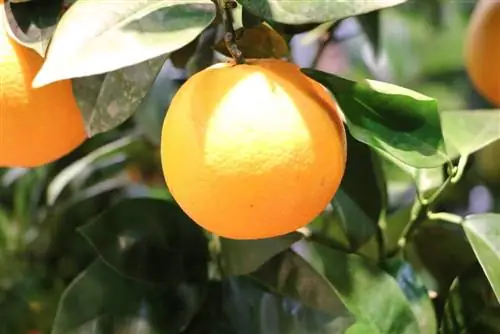
The overwintering of an orange tree should be ended as early as possible. This has the advantage that the plants can thrive under natural conditions for as long as possible, which makes them more resistant to diseases. If the temperatures rise above 10 degrees at night, you can go outside again. In mild regions this is usually the case at the beginning of April and in cold regions, at the end of April to the beginning of May. However, you shouldn't expose them to the blazing sun straight away, but rather gradually get them used to the new conditions. To do this, initially place them in a shady place protected from drafts.
Creation/propagation
There are different ways to get new orange plants:
Sowing
Before you propagate an orange tree from seeds, you should know that the plants grown in this way do not produce fruit. If you still want to try it, you can sow the seeds as normal in potting soil, for example made from coconut fiber. Then place the whole thing in a warm and bright place and keep the substrate constantly moist until germination. When the seedlings are seven to ten centimeters tall, they can be repotted.
Cuttings
- Cut 10-15 cm long, slightly woody cuttings in spring
- With three to five intact buds
- Remove lower leaves, dip interface in rooting powder
- Place in small pots with a mixture of sand and potting soil
- Two buds should be covered with soil
- Water the cuttings and cover with translucent foil
- Soil temperatures of approx. 28 degrees optimal
- Root formation after four to six weeks
- After the first leaves appear, remove the foil
- Transplanting as soon as pots are rooted
Tip:
When the plants eventually produce fruit, they reach their final size in autumn/winter. They turn from a rich green to a bright orange and are ready to harvest.
Diseases & Pests
Even if you put a lot of effort into care, illnesses or pest infestations can still occur. In such cases, acting quickly is often the only salvation for the orange plant. We show you how to recognize the problem and combat it successfully.
Chlorosis
Chlorosis is the yellowing of the leaves. This can be caused by an iron or calcium deficiency. Both can be remedied very well with appropriate fertilization.
Base rot
Base rot is highly contagious and manifests itself as dark spots on the lower trunk area and gum flow. Later, the leaves fall off, branches begin to die and the bark flakes off. Control is not possible and the plant in question must be disposed of.
Scale insects
Small dark plates and sticky honeydew on the leaves indicate a scale insect infestation. The pests can be easily removed with a strong jet of water and a toothbrush. In addition, products containing rapeseed oil or a solution of soapy water are suitable for spraying.
Spider mites
A spider mite infestation is evident in fine, silvery-white webs. Repeated treatments with sulfur preparations and also predatory mites have proven successful several times to combat them.
mealybugs and mealybugs
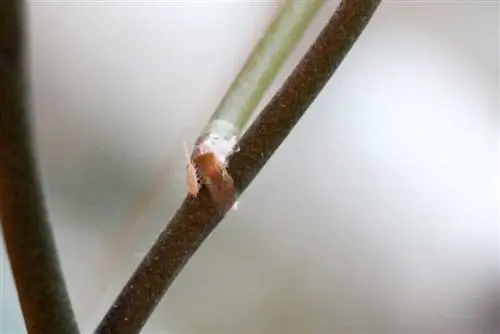
An infestation with mealybugs and mealybugs can be recognized by white, cotton or powder-like webs. They can be combated, for example, with a spray solution made from soap, vinegar and lemon juice and the additional use of parasitic wasps or the Australian ladybird.

